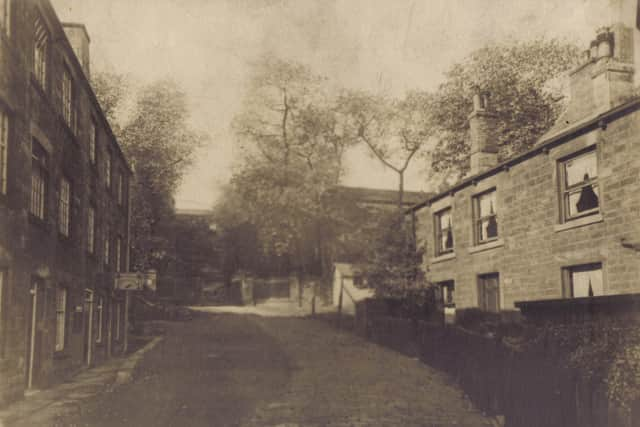Nostalgia with Margaret Watson: Capturing shared memories of Dewsbury
and live on Freeview channel 276
Margaret Watson writes: And, most rewarding of all is they not only want to give me details but also to share their memories of places fast disappearing.
Interestingly, they also tell me things I had no knowledge of, which always help me to research further and weave the information into an article for this column.
Advertisement
Hide AdAdvertisement
Hide AdThey give me details of places long forgotten and also about the people who lived there and the industries which flourished there.


Also the shops which served local communities, the churches where they worshipped and the pubs they visited.
Recently, I have repeated a number of articles which I wrote some years ago and which I show again because so many readers have requested me to do so.
Last week I showed an old photograph of Park Street, Crackenedge, taken before most of the area was demolished, which I wrote about some years ago.
Advertisement
Hide AdAdvertisement
Hide AdIt was one of a number believed to have been taken by the old Dewsbury Corporation in the 1930s.
They were believed to have been taken when the council were planning to demolish whole areas they were describing as slum areas.
But, the war years intervened, and so their plans were put on hold until the 1950s, 60s and 70s.
Those living in slum clearance areas were mainly from the Eightlands, Flatts, Batley Carr, Springfield and Eastborough.
Advertisement
Hide AdAdvertisement
Hide AdSomething like 10,000 families from these areas were re-housed in new council houses on the outskirts of town.
Sadly, demolition on such a massive scale meant that not only houses were demolished but also shops, pubs and churches and factories.
This week I am showing another picture I showed some years ago of an area which was demolished to make way for new houses.
At the time I felt it was just off Mill Road, Batley Carr, but wasn’t too sure because there was no name on the picture to identify where it was.
Advertisement
Hide AdAdvertisement
Hide AdI was delighted when a member of the Speight family gave me a written account of exactly where it was.
Here is the account he gave me some years ago after I published the photograph:
“You are right in surmising that it is Batley Carr in the 1930s. The building on the left was the premises of Speight’s Lampshades (my old family business). You can just about see the sign if you look through a magnifying glass.
“They were the premises where ‘bespoke lampshades’ under the trademark ‘Classic’ were manufactured and enjoyed international fame and recognition.
Advertisement
Hide AdAdvertisement
Hide Ad”The mill yard in the foreground leads off Mill Road just above the park, and the stone gates in the centre was the entry to a winding drive that lead to Field House, which was the family home of the Speight family for decades.
“The rooftop seen to the right of centre, housed the showroom where a vast array of prestigious lampshades were on display.
“These showrooms were frequently visited by the top buyers from John Lewis, Harrods, Bainbridge, Peter Jones and the like.
“Speights moved from the premises in Batley Carr to Mirfield in 1960 and the whole area was demolished to make way for housing developments.”
Advertisement
Hide AdAdvertisement
Hide AdThe houses where we once lived holds a fascination for many people.
This is why I receive so many requests from them asking if I can help trace their history.
Also, I get letters from people moving into an old house and wanting to know who had once lived there and something of its history.
I have in the past written about a number of these, including Austin Friars on Springfield Terrace, now converted into flats, Moorlands Hall, now a residential home, and Marlborough House on Marlborough Terrace.
Advertisement
Hide AdAdvertisement
Hide AdThis week, Eleanor Cundell, who was born on Oxford Road, asked if I could help trace the history of her childhood home, which is called Highcliff.
The house is still there and she has already researched much of its history, but would love to find an old photograph of how it looked when it was built.
She has searched far and wide in the hope of finding one which might have been taken by previous owners but to no avail.
She even tried to contact ancestors of the people who once lived there in the hope they could help, but again no luck.
Advertisement
Hide AdAdvertisement
Hide AdEleanor did manage to track down the original plans for the house, which was built in 1868 and designed by Stead Ellis, architect.
The plans were made by Richard Ward, who later died in 1876, and she found his grave in Hanging Heaton churchyard which said: “Richard Ellis of Highcliff”.
She also discovered the next person to own Highcliff was Joseph Tong Tolson, a locally famous and very wealthy blanket manufacturer.
He lived in the house right until his death in 1910.
His wife, Ellen, and their children continued to live there until 1913 when she passed away.
Advertisement
Hide AdAdvertisement
Hide AdAgain, the name “Highcliff” was engraved on his gravestone in Earlsheaton graveyard.
In 1913 the house was sold to Emily Pickering, who had previously lived at Ravensleigh where her husband took his own life.
She then moved further down Oxford Road to a house called “Lynwood” and then to “Highcliff” until her death in 1950.
I learn so much about social history when I speak to those who lived in these areas because when they are no longer with us, who will be here to tell the story?
You can email your recollections and/or photographs of Dewsbury in years gone by to: [email protected]